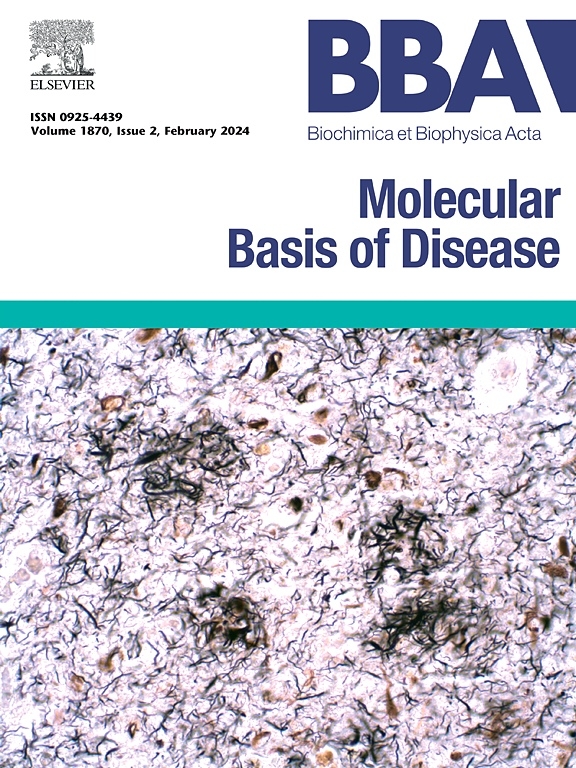肾小管S100A7a通过细胞内和细胞外途径损害脂肪酸氧化并加剧肾纤维化。
IF 4.2
2区 生物学
Q2 BIOCHEMISTRY & MOLECULAR BIOLOGY
Biochimica et biophysica acta. Molecular basis of disease
Pub Date : 2025-01-06
DOI:10.1016/j.bbadis.2025.167656
引用次数: 0
摘要
据报道,一对S100家族蛋白(S100)在肾纤维化(RF)的进展中发挥促炎功能。S100A7不像某些在上皮细胞和间质炎症细胞中均表达的S100A7,在上皮细胞中表达受限。持续的S100A7表达发生在一些侵袭性癌中,并与不良预后因素相关。然而,它是否与肾小管上皮细胞损伤和肾脏疾病有关仍未研究。在这项研究中,我们证明S100A7在小鼠肾纤维化病变和慢性肾脏疾病(CKD)患者肾活检的小管细胞中高度上调。肾脏S100A7水平与CKD患者肾功能下降和肾纤维化进展相关。过表达S100A7a会损害近端小管细胞(ptc)的脂肪酸氧化(FAO)并促进脂质过氧化。机制上,S100A7a与β-catenin相互作用,从而阻止其被β-TrCP-SCF复合物泛素化和降解,进而激活β-catenin信号传导,下调PGC-1α的表达。此外,S100A7a通过RAGE-p-ERK-NOX2途径加剧脂质过氧化。小管细胞中S100a7a的特异性缺失增强了脂肪酸氧化(FAO),减少了脂质过氧化,从而改善肾功能,减轻单侧输尿管梗阻和单侧缺血再灌注损伤引起的肾纤维化。总的来说,我们描述了S100A7a在RF进展中以前未被认识的功能。本文章由计算机程序翻译,如有差异,请以英文原文为准。
Renal tubular S100A7a impairs fatty acid oxidation and exacerbates renal fibrosis via both intracellular and extracellular pathway
A couple of S100 family proteins (S100s) have been reported to exert pro-inflammatory functions in the progression of renal fibrosis. Unlike some S100s which are expressed by both epithelial and stromal inflammatory cells, S100A7 is restricted expressed in epithelium. Persistent S100A7 expression occurs in some invasive carcinomas and is associated with poor prognostic factors. Whereas, whether it is implicated in renal tubular epithelial cell injury and kidney disease remains unexplored. In this study, we demonstrate that S100A7 is highly upregulated in tubular cells of both mouse renal fibrotic lesions and kidney biopsies from patients with chronic kidney disease (CKD). The level of renal S100A7 was associated with both the decline of renal function and the progression of renal fibrosis in CKD patients. Overexpressing S100A7a impaired fatty acid oxidation (FAO) and promoted lipid peroxidation in proximal tubular cells (PTCs). Mechanistically, S100A7a interacts with β-catenin, thereby preventing its ubiquitination and degradation by the β-TrCP-SCF complex, and in turn activated β-catenin signaling, downregulated the expression of PGC-1α. Additionally, S100A7a exacerbated lipid peroxidation via RAGE-p-ERK-NOX2 pathway. Specific deletion of S100a7a in tubular cells enhanced FAO and reduced lipid peroxidation, resulting in improved renal function and alleviation of renal fibrosis induced by unilateral ureteral obstruction and unilateral ischemia-reperfusion injury. Collectively, we delineate a previously unrecognized function of S100A7a in the progression of renal fibrosis.
求助全文
通过发布文献求助,成功后即可免费获取论文全文。
去求助
来源期刊
CiteScore
12.30
自引率
0.00%
发文量
218
审稿时长
32 days
期刊介绍:
BBA Molecular Basis of Disease addresses the biochemistry and molecular genetics of disease processes and models of human disease. This journal covers aspects of aging, cancer, metabolic-, neurological-, and immunological-based disease. Manuscripts focused on using animal models to elucidate biochemical and mechanistic insight in each of these conditions, are particularly encouraged. Manuscripts should emphasize the underlying mechanisms of disease pathways and provide novel contributions to the understanding and/or treatment of these disorders. Highly descriptive and method development submissions may be declined without full review. The submission of uninvited reviews to BBA - Molecular Basis of Disease is strongly discouraged, and any such uninvited review should be accompanied by a coverletter outlining the compelling reasons why the review should be considered.

 求助内容:
求助内容: 应助结果提醒方式:
应助结果提醒方式:


